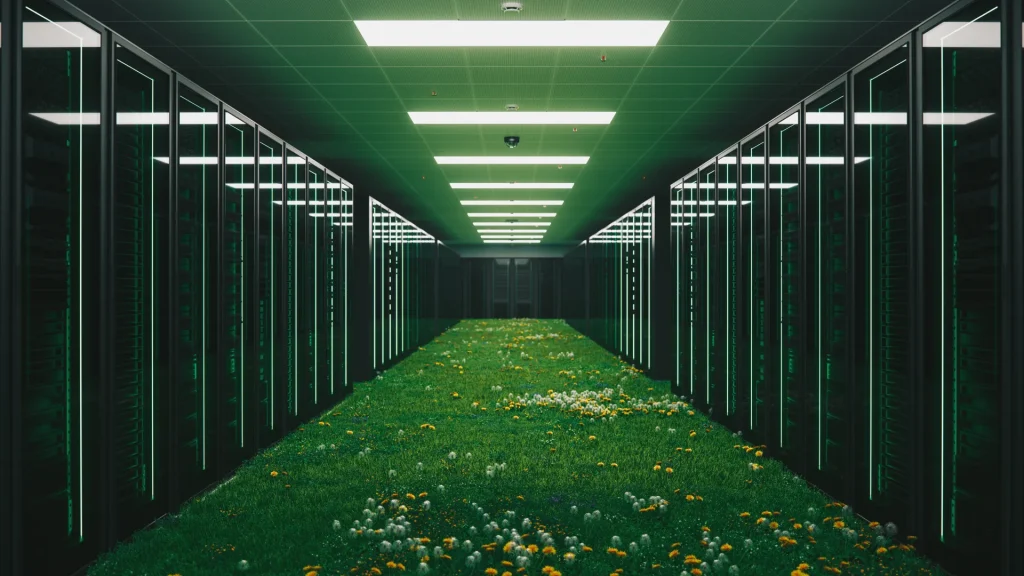Today’s data centers gulp immense amounts of energy and pour tons of carbon into the atmosphere, driving up costs and risking regulatory penalties.
Every spike in power bills and every news headline about climate change reminds IT leaders that traditional infrastructures are no longer sustainable—outdated cooling methods, inefficient servers, and fossil-fuel dependence leave businesses vulnerable to rising energy prices and public backlash.
Here comes the next-gen Green Data Center Technologies: from liquid cooling and AI-driven power management to on-site renewables and modular designs, these innovations slash energy use, cut carbon footprints, and future-proof your operations—so you can keep your servers humming and your planet healthy.
1. Introduction to Green Data Center Technologies
What Is Green Data?
Green data refers to digital information managed in ways that minimize environmental harm. When data moves through servers, it uses electricity. If that power comes from fossil fuels, it generates carbon emissions. What is green data? It’s data processed, stored, and transmitted using cleaner energy, smarter hardware, and sustainable practices. By focusing on Green Data Center Technologies, organizations reduce waste, cut emissions, and still meet growing digital demands.
The Growing Importance of Eco-Friendly Digital Infrastructure
Data centers power everything from video calls to AI. As global data traffic surges—expected to triple by 2030—power needs soar. Today, data centers consume about 1% of global electricity; without change, they could hit 3% by 2035. Businesses face rising energy costs, regulators push stricter limits, and customers demand greener services. That makes Green Data Center Technologies not just an option but a necessity.
The Green data center market is expanding rapidly. From hyperscale operators to colocation providers, everyone invests in sustainable upgrades. Europe leads with strict regulations, while Asia-Pacific ramps up retrofits. In North America, corporate net-zero pledges drive progress. Together, these forces create momentum for a full-scale revolution.
Don’t wait—Contact us now and power your data center with next-gen green technologies!
2. Energy-Efficient Hardware Technologies
Hardware is the heart of any data center. By upgrading to Green Data Center Technologies, you cut both energy use and costs.
Liquid Cooling Systems vs. Air Cooling
Air cooling pushes cold air through raised floors and server racks. It relies on large chillers, fans, and airflow management. In contrast, liquid cooling uses water or dielectric fluids circulated close to chips. By contacting heat sources directly, liquid cooling slashes energy needs. Studies show energy savings up to 40% compared to air cooling. Many Green data center examples—from hyperscale to enterprise—report lower PUE scores when they switch to liquid cooling.
- Higher Thermal Conductivity: Liquids carry heat away faster.
- Greater Density: Pack more compute power per rack.
- Reduced Noise: Fewer fans and blowers.
Energy-Efficient Servers and CPUs
Next-gen servers use low-power processors and custom chips. ARM-based CPUs, FPGAs, and ASICs tailor compute to specific tasks, avoiding generic overcapacity. These chips often feature dynamic voltage and frequency scaling. They throttle power based on workload, cutting consumption by 20–30%. Deploying such energy-efficient servers is a core element of any Green Data Center Technologies roadmap.
- Fine-Grained Control: Match performance to demand.
- Optimized Designs: Custom silicon for AI, analytics, or storage.
- Real Deployments: Leading colocation providers report major savings with low-power CPUs.
Advanced Power Management Units (PMUs)
PMUs monitor and regulate power at the rack or board level. They use simple on-board intelligence to predict load spikes and shift power accordingly. Smart PMUs throttle non-critical systems during peak hours and balance load across racks. This reduces wasted wattage and smooths demand spikes. Integrating PMUs is essential for modern Green Data Center Technologies.
- Real-Time Monitoring: Track power draw per device.
- Load Prediction: AI-enhanced forecasts for better planning.
- Efficient Distribution: Direct power where it’s needed most.
By combining liquid cooling, low-power chips, and advanced PMUs, data centers can achieve dramatic energy reductions. These technologies lay the groundwork for deeper sustainability initiatives, paving the way toward net-zero operations.
Curious how much you could save? Contact us to pursue top-tier Green data center certification and lead your industry.
3. Renewable Energy Integration
Shifting from fossil fuels to renewables is a cornerstone of Green Data Center Technologies. On-site generation and off-site procurement both play key roles.
On-Site Solar and Wind Installations
Installing solar panels on rooftops or nearby fields lets data centers generate clean power directly. Small wind turbines can serve as complementary sources. One campus in California covers 45% of its daytime load with solar arrays. Another in Spain pairs solar with micro-wind units to smooth output. These Green data center examples demonstrate how on-site renewables cut emissions and lower utility bills.
- Upfront Costs: Panels and turbines require significant investment.
- Space Needs: Rooftops or adjacent land must be available.
- Savings: 20–50% reduction in grid power usage.
China built hundreds of AI Data Centers To Catch The AI Boom | Reboot Monkey
Renewable Energy Certificates (RECs) and Power Purchase Agreements (PPAs)
When on-site output falls short, data centers buy RECs or sign PPAs. RECs certify that a matching amount of green power fed the grid on your behalf. PPAs guarantee long-term green power prices by funding new wind or solar farms. Together, these tools let operators claim 100% renewable usage and meet corporate ESG targets. Many global colos now boast clean energy portfolios built through these mechanisms.
- Financial Certainty: Lock in rates for 10–20 years.
- Regulatory Compliance: Align with net-zero mandates.
- Market Impact: Drive development of new renewable projects.
Battery Storage and Grid Independence
Energy storage is revolutionizing Green Data Center Technologies. Lithium-ion, flow batteries, and emerging chemistries store surplus renewable power for peak demand or outages. A multi-megawatt battery array can maintain full operations during grid failures. Storage also enables “peak shaving,” drawing from batteries at expensive times and recharging when rates drop. With storage, facilities increase their resilience and further slash carbon footprints.
- Resilience: Backup power without diesel gensets.
- Cost Savings: Avoid peak demand charges.
- Grid Services: Provide frequency regulation and load balancing.
By integrating renewables and storage, data centers become energy independent. They reduce reliance on fossil-fueled grids and cut both scope 1 and scope 2 emissions—core goals for any Green Data Center Technologies strategy.
4. Cooling and Thermal Management Innovations
Cooling typically accounts for 30–40% of a data center’s total energy use. Next-gen Green Data Center Technologies tackle this head-on.
Direct-to-Chip Liquid Cooling
Direct-to-chip systems circulate coolant through cold plates on CPUs and GPUs. This yields the highest thermal transfer efficiency. Deployments report up to 90% water use reduction compared to evaporative cooling and up to 50% energy savings. Direct-to-chip is a hallmark of advanced Green Data Center Technologies, especially in high-density AI and HPC environments.
- Minimal Water Use: Closed-loop systems limit consumption.
- High Density: Support racks with >50 kW per rack.
- Lower Energy: Reduced fan and chiller load.
Outside Air Economization
Air-side economization brings in filtered outside air when conditions permit. In cool climates, this can replace mechanical cooling for 6–10 months annually. Data centers in Switzerland and Scandinavia regularly achieve 70–80% free cooling. Indeed, the Green data center market leads in these practices, achieving PUEs as low as 1.1.
- Extended Free Cooling Windows: Major seasonal savings.
- Reduced MA: Fewer moving parts running year-round.
- High Reliability: Less chiller dependency.
5 Essential Interview Strategies for Hiring Top Technical Talent! | Reboot Monkey
Immersion Cooling
Immersion cooling involves submerging servers in dielectric liquids. It eliminates fans and chillers entirely for cooled racks. Immersion deployments often hit PUE under 1.05. Although initial capital costs are higher, the long-term gains in Green Data Center Technologies and OPEX are compelling.
- No Fans: Silent operation and fewer maintenance points.
- Compact Footprint: Smaller rack spacing.
- Exceptional Efficiency: Direct heat transfer to fluid.
By adopting direct-to-chip, outside air economization, and immersion, data centers push cooling toward zero energy consumption, marking a new milestone for sustainable infrastructure.
5. Modular and Prefabricated Green Data Centers
Modular design offers speed, flexibility, and sustainability advantages essential to Green Data Center Technologies.
What Are Modular Data Centers?
Modular data centers are prefabricated blocks—often containerized or panel-based—built off-site. After factory assembly, modules ship to sites where they connect in days or weeks. Unlike traditional builds, modular units reduce onsite construction waste and errors. They embody What is green data by slashing material use and accelerating deployment.
- Rapid Build: Weeks vs. months for traditional construction.
- Quality Control: Factory conditions ensure precision.
- Scalable: Easily add capacity as demand grows.
How Modular Data Centers Enhance Sustainability
How Modular Data Centers Enhance Sustainability by:
- Reducing Waste: Standardized cuts and fittings minimize scrap.
- Recyclable Materials: Steel frames and eco-panels.
- Optimized Logistics: Lower transport footprints through modular batching.
Modules often integrate pretested Green Data Center Technologies—from liquid cooling skids to integrated solar canopies—further boosting green credentials.
Case Study: Modular Deployment in Action
A telecom firm in Canada deployed 10 prefabricated modules in rural regions. Build time shrank by 60%, while construction waste fell by 35%. The operator integrated rooftop solar on each module, covering 25% of on-site power needs. This Green data center case study highlights how modular design and Green Data Center Technologies combine to deliver rapid, sustainable expansion.
Contact Reboot Monkey today for a consultation or quote. Let’s build a faster, more reliable experience for your users—starting now.
6. Smart Monitoring and Automation Systems
Data-driven operations are a linchpin of Green Data Center Technologies.
AI-Driven Energy Optimization
AI and machine learning continuously analyze power usage, temperatures, and workload patterns. They adjust cooling setpoints, fan speeds, and compute allocations to minimize energy consumption. Google’s DeepMind famously cut cooling energy by 40%, setting a high bar for Green data center examples.
- Adaptive Control: Learn and adjust in real time.
- Dynamic Tuning: Optimize HVAC and rack settings.
- Quantified Savings: Millions of kWh saved annually.
IoT Sensors for Climate and Load Monitoring
Hundreds of tiny IoT sensors measure temperature, humidity, airflow, and power draw at the rack level. Dashboards visualize hotspots and inefficiencies, triggering alerts when metrics stray from optimal ranges. This granular monitoring is foundational for next-gen Green Data Center Technologies.
- Fine-Grained Data: Spot issues before they escalate.
- Automated Alerts: Rapid response to anomalies.
- Energy Dashboards: Track PUE, DCiE, and other KPIs.
Predictive Maintenance and Resource Allocation
Advanced analytics predict hardware failures—fans, drives, and power supplies—before they occur. Maintenance schedules shift to low-impact windows, reducing downtime and preventing waste. Extending equipment lifecycles and avoiding emergency replacements are key benefits of smart automation in Green Data Center Technologies.
7. Sustainable Data Center Materials and Design
Physical infrastructure choices shape a data center’s embodied carbon—a critical factor in true sustainability.
Recyclable and Low-Carbon Building Materials
Traditional concrete emits significant CO₂ during production. Low-carbon alternatives—using fly ash, slag, or calcined clay—cut emissions by 40–60%. Recycled steel requires 70% less energy than virgin steel. Biodegradable plastics replace single-use plastics in offices and packaging. These materials underpin modern Green Data Center Technologies by lowering supply-chain emissions.
Low-Energy Building Design
Passive design strategies—daylight harvesting, high-performance insulation, and strategic airflow paths—reduce mechanical loads. Natural ventilation and thermal mass work together to stabilize indoor temperatures. Such architectural innovations demonstrate how the building envelope itself becomes part of the cooling and heating system, advancing Green Data Center Technologies beyond the data hall.
The Role of a Data Center Operator: Powering the Digital World | Reboot Monkey
8. Certifications and Global Green Standards
Certifications validate your commitment and guide continuous improvement in Green Data Center Technologies.
Overview of Green Data Center Certification Bodies
Key bodies include:
- LEED: Gold standard for green buildings.
- ENERGY STAR: Certification for efficient facilities.
- ISO 50001: Framework for energy management.
- BREEAM: U.K. environmental assessment.
Achieving Green data center certification signals credibility to customers and regulators.
Region-Specific Certifications: Europe and Switzerland
Europe’s Taxonomy Regulation defines criteria for green assets. Switzerland adds its own Green data center ch regulations on efficiency and renewables. InfraVia’s investor-led Green data center InfraVia standards build on these to guide capital toward truly sustainable data halls.
- EU Taxonomy: Sets uniform green criteria.
- Swiss EcoLabels: Nationals standards for efficiency and emissions.
- InfraVia Benchmarks: Investment-grade sustainability metrics.
How to Achieve Certification: Step-by-Step
- Baseline Audit: Measure energy use and emissions.
- Target Setting: Align with ISO 50001 and GRI standards.
- Implement Technologies: Use this guide’s Green Data Center Technologies.
- Third-Party Audit: Obtain LEED, ENERGY STAR, or BREEAM.
- Continuous Improvement: Maintain and improve through regular reporting.
9. Market Trends and Investment Outlook
The financial landscape around Green Data Center Technologies is vibrant and growing.
Growth of the Green Data Center Market
Analysts forecast the Green data center market to exceed $45 billion by 2027 at a 12% CAGR. North America leads in new builds, Europe focuses on retrofits, and Asia-Pacific surges under strict carbon regulations. This growth arises from corporate ESG targets, carbon pricing, and consumer demand for sustainable services.
Venture Capital and Government Support
VC funds—particularly those tied to Green data center InfraVia—invest heavily in startups tackling cooling, AI-driven optimization, and renewable integration. Governments offer grants, tax credits, and green bonds to support sustainable infrastructure. Public-private partnerships now finance major green data park projects in Singapore, Germany, and Canada.
Predictions for the Next 5–10 Years
- AI-Powered Microgrids: Data parks that self-optimize energy flows.
- Quantum Cooling Research: Lab breakthroughs applying quantum materials for heat transfer.
- Edge-Focused Green Pods: Small, modular centers near end users, cutting latency and carbon.
These future trends will deepen the impact of Green Data Center Technologies, making sustainable infrastructure the norm rather than the exception.
Key Takeaways:
In summary, next-gen Green Data Center Technologies offer a clear roadmap to a sustainable digital future. By combining energy-efficient hardware—like liquid cooling, low-power CPUs, and advanced PMUs—with on-site renewables, RECs/PPAs, and battery storage, data centers can slash both carbon emissions and operating costs.
Choosing low-carbon materials and pursuing Green data center certification under frameworks like LEED, ENERGY STAR, ISO 50001, and EU/Swiss standards validates your commitment. With the Green data center market set to exceed $45 billion and robust funding available, there’s never been a better time to act.
Partner with us to build your bespoke Green Data Center Technologies roadmap. Subscribe to our Green Tech Insights and pursue top-tier Green data center certification. Contact our team today and lead the sustainable infrastructure revolution!
FAQs:
Q: What are Green Data Center Technologies?
A: Green Data Center Technologies encompass energy-efficient hardware, renewable integration, and smart cooling methods to minimize environmental impact.
Q: How do Green Data Center Technologies reduce operational costs?
A: By deploying liquid cooling, low-power processors, and AI-driven energy optimization, Green Data Center Technologies lower electricity bills and maintenance expenses.
Q: Can existing facilities adopt Green Data Center Technologies?
A: Yes—through retrofits like outside-air economization, modular upgrades, and battery storage, existing data centers can implement Green Data Center Technologies without full rebuilds.
Q: What role do certifications play in Green Data Center Technologies?
A: Certifications such as LEED, ENERGY STAR, and ISO 50001 validate that Green Data Center Technologies meet industry standards for sustainability and efficiency.
Q: Why is the Green Data Center Technologies market growing?
A: With global data demand rising and stricter carbon regulations, organizations invest in Green Data Center Technologies to achieve net-zero goals and enhance brand reputation.




